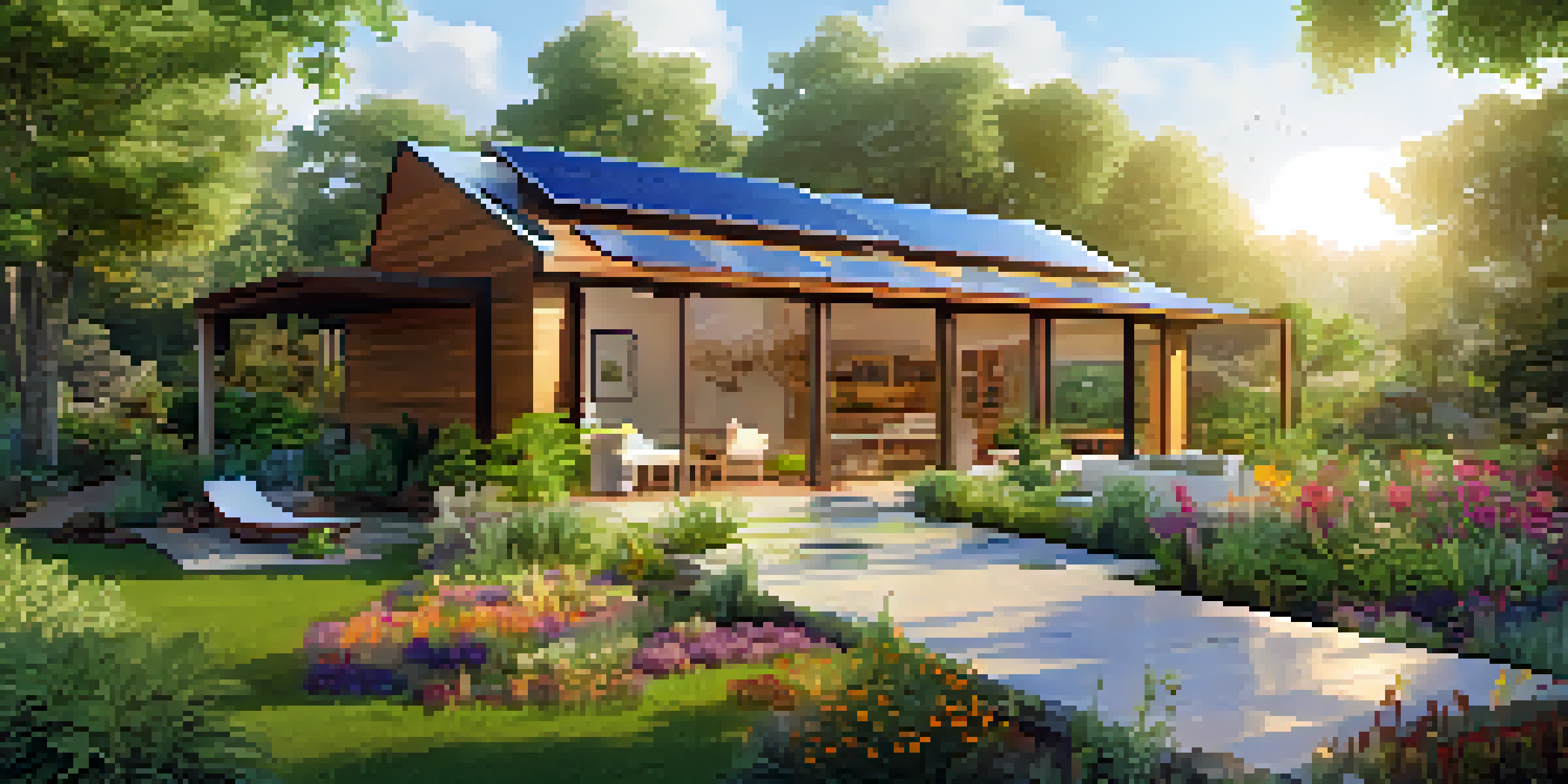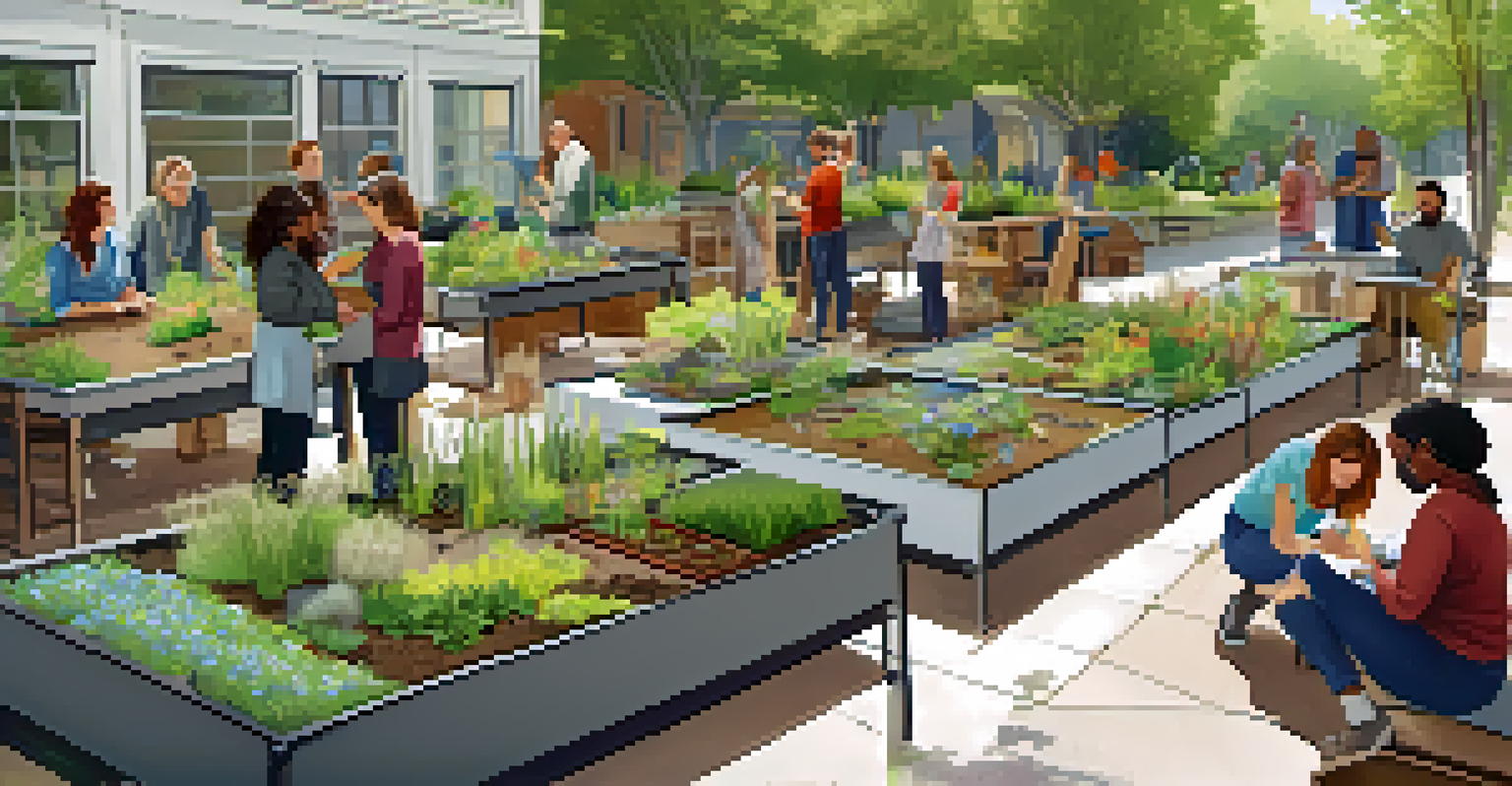The Benefits of Sustainable Home Design Education

Understanding Sustainable Home Design Principles
Sustainable home design revolves around creating spaces that minimize environmental impact. This approach encompasses energy efficiency, resource conservation, and the use of eco-friendly materials. By understanding these principles, homeowners can make informed decisions that benefit both their living environment and the planet.
The greatest threat to our planet is the belief that someone else will save it.
For instance, using solar panels or rainwater harvesting systems not only reduces utility bills but also contributes to a healthier ecosystem. Educating individuals about these concepts fosters a sense of responsibility towards natural resources. As more people embrace these ideas, the collective impact on sustainability becomes significant.
Moreover, this knowledge empowers homeowners to advocate for greener practices within their communities. By sharing insights on sustainable home design, they can inspire others to consider eco-friendly alternatives. Ultimately, understanding these principles sets the foundation for a more sustainable future.
Enhancing Energy Efficiency in Homes
One of the main benefits of sustainable home design education is its focus on energy efficiency. This encompasses various strategies, such as improved insulation and energy-efficient appliances, which can significantly reduce energy consumption. By learning about these methods, homeowners can make practical changes that lead to lower energy bills.

For example, a well-insulated home keeps temperatures stable, reducing the need for heating and cooling systems to work overtime. This not only saves money but also lowers carbon emissions, benefiting the environment. Education plays a crucial role in helping individuals recognize the importance of these upgrades.
Sustainability Enhances Living Spaces
Sustainable home design prioritizes the health and well-being of occupants through the use of non-toxic materials and natural elements.
As more people become aware of their energy usage, there’s a ripple effect that encourages broader community efforts towards efficiency. Sustainable design education equips individuals with the knowledge to advocate for collective initiatives, making energy conservation a shared goal.
Promoting Health and Well-being in Living Spaces
Sustainable home design is not just about the environment; it also prioritizes the health of its occupants. Educating individuals about the importance of using non-toxic materials can lead to healthier living spaces. This can include choosing paints with low volatile organic compounds (VOCs) and utilizing natural building materials.
Sustainability is no longer about doing less harm. It’s about doing more good.
For instance, a home designed with sustainable materials can significantly reduce indoor air pollution, creating a more comfortable and safe living environment. When people are educated about these options, they become more aware of how their choices impact their health and well-being.
Additionally, sustainable design often incorporates natural elements, such as light and greenery, which can enhance mental health. By learning about these benefits, individuals can create spaces that support both their physical health and emotional well-being.
Encouraging Economic Savings and Value
Investing in sustainable home design can lead to significant long-term savings. Homeowners educated in this area learn about the financial benefits of energy-efficient appliances and renewable energy systems. Although the initial investment might be higher, the reduction in utility costs often leads to substantial savings over time.
Moreover, homes designed with sustainability in mind typically have higher resale values. Buyers are increasingly seeking properties that align with eco-friendly principles, making these homes more attractive on the market. Understanding these economic advantages empowers homeowners to make informed decisions regarding their investments.
Economic Benefits of Sustainable Homes
Investing in sustainable home design can lead to long-term savings and higher resale values, making eco-friendly properties increasingly attractive.
Additionally, as awareness of environmental issues grows, so does the demand for sustainable homes. Homeowners who embrace these designs can benefit from government incentives and tax breaks aimed at promoting green building practices, further enhancing their financial position.
Fostering Community and Environmental Responsibility
Sustainable home design education creates a sense of community among like-minded individuals. As homeowners gain knowledge about sustainable practices, they often share their experiences and ideas with neighbors and friends. This collaborative spirit promotes a culture of sustainability that extends beyond individual homes.
For instance, local workshops or community gardens can emerge from these discussions, bringing people together to implement sustainable initiatives. As individuals work collectively towards common goals, they build stronger relationships while fostering environmental stewardship.
Furthermore, this sense of community encourages collective action in addressing larger environmental issues. Educated homeowners can advocate for policies that support sustainability at the local and national levels, amplifying their impact on the environment.
Inspiring Future Generations to Embrace Sustainability
Education in sustainable home design is not just for current homeowners; it paves the way for future generations. Teaching children and young adults about eco-friendly practices instills a sense of responsibility towards the planet. As these individuals grow, they carry these values into their own lives and homes.
For example, when children learn about composting and energy conservation, they develop habits that can last a lifetime. This early education creates a generation that prioritizes sustainable living, ensuring that environmental considerations are at the forefront of future home design.
Education Fuels Community Action
Educating homeowners about sustainable practices fosters a sense of community responsibility and encourages collective efforts towards environmental stewardship.
Moreover, inspiring youth to engage in sustainability can lead to innovative solutions for environmental challenges. By nurturing these values, we equip the next generation with the tools to create a more sustainable world.
Building Resilience Against Climate Change
Sustainable home design education plays a crucial role in preparing individuals for the challenges posed by climate change. By understanding how to design homes that are resilient to extreme weather events, homeowners can protect their investments and ensure safety. This includes features like elevated foundations and storm-resistant materials.
For instance, homes built with sustainability in mind can withstand floods and storms better than traditional designs. Educating individuals about these strategies empowers them to take proactive measures in safeguarding their properties against climate-related risks.

Furthermore, as communities become more resilient, they contribute to broader efforts in combating climate change. Homeowners equipped with knowledge about sustainable design can influence local policies and practices, leading to more robust community responses to environmental challenges.
Conclusion: The Path to a Sustainable Future
In conclusion, sustainable home design education offers myriad benefits that extend beyond individual homes. From enhancing energy efficiency to fostering community responsibility, the impact is profound. By understanding and implementing sustainable practices, homeowners can contribute to a healthier planet and society.
Furthermore, as more individuals embrace these principles, they create a ripple effect that promotes broader environmental awareness. This collective movement can lead to significant advancements in sustainability at local, national, and global levels.
Ultimately, investing in education on sustainable home design is investing in a better future for ourselves and generations to come. Together, we can pave the way for a more sustainable world.